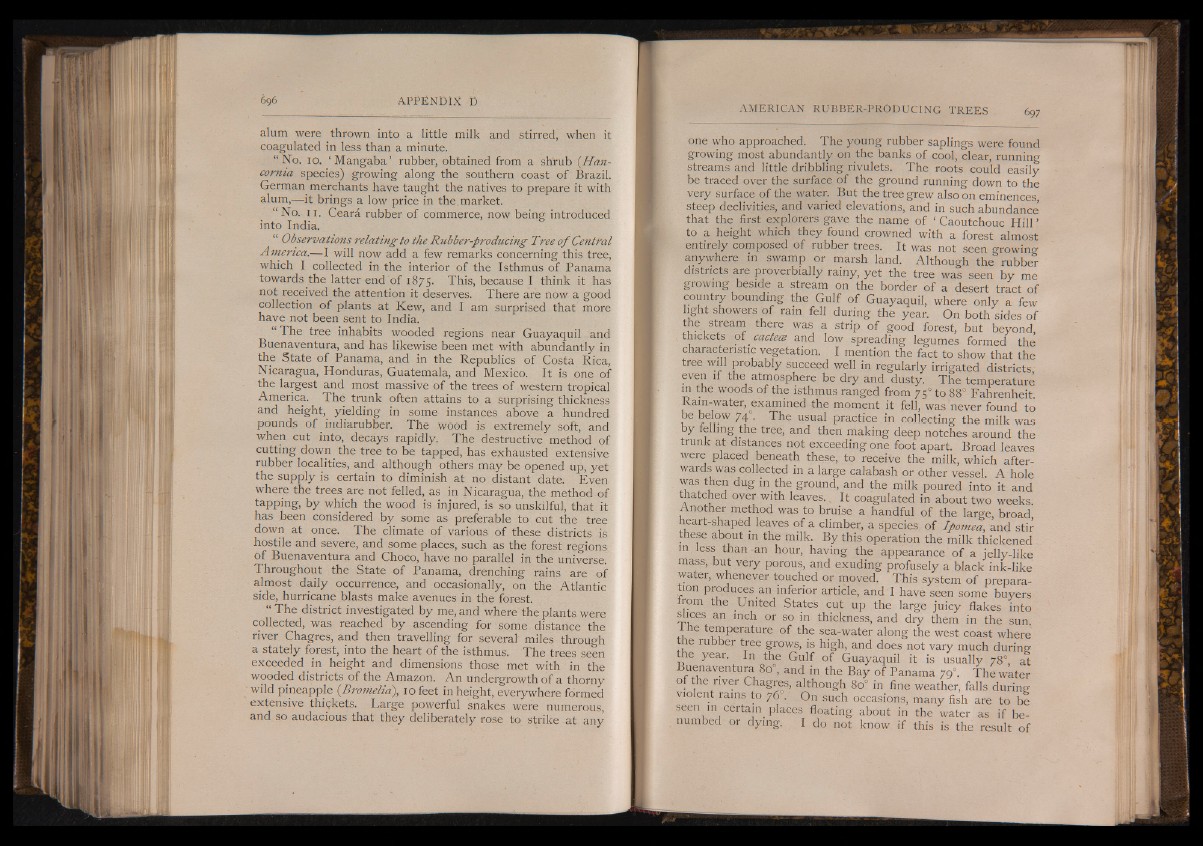
alum were thrown into a little milk and stirred, when it
coagulated in less than a minute.
“ No. 10. ‘ Mangaba’ rubber, obtained from a shrub (Han-
comia species) growing along the southern coast of Brazil.
German merchants have taught the natives to prepare it with
alum,— it brings a low price in the market.
“ No. i i . Ceara rubber of commerce, now being introduced
into India.
“ Observations relating to the Rubber-producing Tree o f Central
America.— I will now add a few remarks concerning this tree,
which I collected in the interior of the Isthmus of Panama
towards the latter end of 1875- This, because I think it has
not received the attention it deserves. There are now a good
collection of plants at Kew, and I am surprised that more
have not been sent to India.
“ The tree inhabits wooded regions near Guayaquil and
Buenaventura, and has likewise been met with abundantly in
the State of Panama, and in the Republics of Costa Rica,
Nicaragua, Honduras, Guatemala, and Mexico. It is one of
the largest and most massive of the trees of western tropical
America. The trunk often attains to a surprising thickness
and height, yielding in some instances above a hundred
pounds of indiarubber. The wood is extremely soft, and
when cut into, decays rapidly. The destructive method of
cutting down the tree to be tapped, has exhausted extensive
rubber localities, and although others may be opened up, yet
the supply is certain to diminish at no distant date. Even
where the trees are not felled, as in Nicaragua, the method of
tapping, by which the wood is injured, is so unskilful, that it
has been considered by some as preferable to cut the tree
down at once. The climate of various of these districts is
hostile and severe, and some places, such as the forest regions
of Buenaventura and Choco, have no parallel in the universe.
Throughout the State of Panama, drenching rains are of
almost daily occurrence, and occasionally, on the Atlantic
side, hurricane blasts make avenues in the forest.
“ The district investigated by me, and where the plants were
collected, was reached by ascending for some distance the
river Chagres, and then travelling for several miles through
a stately forest, into the heart of the isthmus. The trees seen
exceeded in height and dimensions those met with in the
wooded districts of the Amazon. An undergrowth of a thorny
wild pineapple {Bromelia), 10 feet in height, everywhere formed
extensive thickets. Large powerful snakes were numerous,
and so audacious that they deliberately rose to strike at any
one who approached. The young rubber saplings were found
growing most abundantly on the banks of cool, clear, running
streams and little dribbling rivulets. The roots could easily
be traced over the surface of the ground running down to the
very surface of the water. But the tree grew also on eminences
steep declivities, and varied elevations, and in such abundance*
that the first explorers gave the name of | Caoutchouc Hill ’
to a height which they found crowned with a forest almost
entirely composed of rubber trees. It was not seen growing
anywhere in swamp or marsh land. Although the rubber
districts are proverbially rainy, yet the tree was seen by me
growing beside a stream on the border of a desert tract of
country bounding the Gulf of Guayaquil, where only a few
light showers of rain fell during the year. On both sides of
^ stream there was a strip of good forest, but beyond,
thickets of cactece and low spreading legumes formed the
characteristic vegetation. I mention the fact to show that the
tree will probably succeed well in regularly irrigated districts
even if the atmosphere be dry and dusty. The temperature
m the woods of the isthmus ranged from 750 to 88° Fahrenheit.
Rain-water, examined the moment it fell, was never found to
be below 74 . The usual practice in collecting the milk was
by ielling the tree, and then making deep notches around the
trunk at distances not exceeding one foot apart. Broad leaves
were placed beneath these, to receive the milk, which afterwards
was collected in a large calabash or other vessel. A hole
was then dug in the ground, and the milk poured into it and
thatched over with leaves.. It coagulated in about two weeks
Another method was to bruise a handful of the large, broad
heart-shaped leaves of a climber, a species of Ipomea, and stir
these about m the milk. By this operation the milk thickened
in less than an hour, having the appearance of a jelly-like
mass, but very porous, and exuding profusely a black ink-like
water, whenever touched or moved. This system of preparation
produces an inferior article, and I have seen some buyers
irom the United States cut up the large juicy flakes into
Mices an inch or so in thickness, and dry them in the sun.
lH te™Perature of the sea-water along the west coast where
the rubber tree grows, is high, and does not vary much during
the year. In the Gulf of Guayaquil it is usually 78°, at
Buenaventura 80°, and in the Bay of Panama 79°. The water
of the river Chagres, although 80° in fine weather, falls during
violent,rains to 76 . On such occasions, many fish are to be
seen m certain places floating about in the water as if benumbed
or dying. I do not know if this is the result of